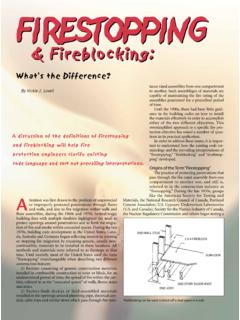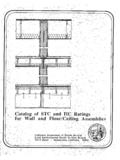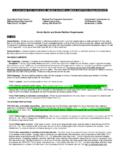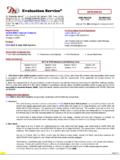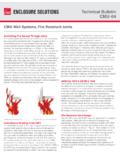Transcription of FCIA MOP Sec 6 App G ID Systems 10-28-08 FINAL
1 FCIA Firestop Manual of Practice Page 1 Date of Issue 10/29/2008 Revision No. 3 FCIA Identification Systems for Firestopping - Suggested Fire Resistance Rated Assembly Identification and Labeling in Effective Compartmentation Appendix D ======================================== ============== Background - Identification Systems for Firestop Systems The purpose of this document is to outline the various options for labeling, or Identification Systems for Firestop Systems . It is the responsibility of the design professional, architect, engineer and or Authority Having Jurisdiction to require an identification system for a building using project specifications or other construction documents as the communication tool to the contractor. Construction documents should also be specific instructing the contractor which labeling method to use. Codes may require an identification system communicated to the design professional through code requirements depending on the jurisdiction.
2 The purpose of this section is to provide a discussion of identification Systems , or labeling, the history, options available in the industry, plus sample templates. How does a firestop contractor, design professional, building owner or manager know if a wall or floor is fire resistance rated? What about the hole in the wall / floor with red sealant in it .. is it a fire resistance rated or smoke, radiation, chemical, biological, blast or other resistant wall (or floor) with a fire resistance rated firestop system installed? What firestop system number, manufacturer and contractor were used for the Firestop System? How does an inspector know what he/she is looking at when reviewing the firestop Systems during annual reviews of the building safety Systems ? Answers to these questions may be found through this Identification Systems for Firestopping document.
3 FCIA Members have had requests from building owners, design professionals and others to install labels identifying what firestop system was used on installations in various types fire resistance rated assemblies in buildings. This is in addition to identification of the fire resistance-rated assembly wall or floor. Many FCIA Member Firestop Contractors have provided several types of labels and stencils to identify fire resistance-rated assemblies and firestop Systems through those assemblies to meet requirements. The first requests for identification Systems for firestop Systems developed in the Nuclear Power Industry. In this environment, a through penetration firestop system (penetration seal as it is known in nuclear plants) was identified through a specific identification number at the penetration seal area on a wall or floor, with a number which corresponded to a file in the central record keeping area.
4 The complete tested system documentation for that firestop system would be documented in this file, with test results, hourly fire ratings, radiation or pressure certifications and other information pertinent to that specific firestop system. FCIA Firestop Manual of Practice Page 2 Date of Issue 10/29/2008 Revision No. 3 Industrial building owners have also requested identification Systems for firestopping in the field. Some commercial, educational, health care and other occupancies have requested identification Systems for fire resistance rated assemblies and firestopping over the years as well. The FM Standard, (FM 4991) Standard for the Approval of Firestop Contractors, Class 4991, discusses labeling of penetrations. FM 4991 does not require labels, unless the design professional or owner requests it of the FM Approved Contractor through the construction documents.
5 If an identification system is required, the FM 4991 Contractor invokes a special procedure outlined in the standard. See FM 4991 for specific installation instructions and label content. The UL Qualified Firestop Contractor Program has no requirements written for labeling other than to follow customer requirements. FCIA Member Firestop Contractors, Manufacturers and Associate members, have reported an increased demand for identification Systems by building owners and managers, design professionals and generally provide as required by specification. What is identification? Identification for Fire Resistance Rated assemblies is not new to the construction industry and effective compartmentation. Stencil painted fire walls, or large label attachments have shown hourly fire resistance ratings and smoke or other resistant Systems for many years.
6 Fire doors have been marked with metal tags riveted to doors and frames with builder s hardware identifying the door as a fire resistance rated assembly. Fire and Smoke Dampers have been sometimes marked as well. Identification for Firestop Systems through labeling has been requested of FCIA Members in various forms to complete the firestopping application. Fire and smoke barrier walls are marked by stencil or labels. Example of a label for fire / smoke resistance rated assembly Downey Construction, Inc. label FCIA Firestop Manual of Practice Page 3 Date of Issue 10/29/2008 Revision No. 3 Doors passing through fire resistance rated assemblies are also required to be fire resistance rated. These Fire Doors are also marked both on the door frame and door assembly. The hardware must also be listed for the specific use in a rated assembly.
7 Firestopping Systems are also installed, and marked by specialty firestop contractors worldwide.. Why Identify Firestop Systems in buildings? There are significant economic, fire and life safety benefits to the building owner and manager when adequate identification Systems are required on projects. The FCIA Member, Firestopping Contractor Professional who installs a firestop identification system saves the firestop inspection firm, AHJ, and building owner significant time during later maintenance and inspection because Systems research is minimized for the inspector and building manager/ engineer. Most important, the DO NOT DISTURB or CONTACT BUILDING PERSONNEL BEFORE ALTERING sign usually indicates to trades or others who might alter the firestop system to stay away. Additionally, identification Systems may be required for fire walls, fire and smoke walls, smoke walls and barriers, or partitions as well.
8 Construction, Inc. label. FCIA Firestop Manual of Practice Page 4 Date of Issue 10/29/2008 Revision No. 3 Construction, Inc., label Post installation building firestop Systems inspection time is reduced as there is little research required by the inspector to identify which system design to locate to perform verification services. If the tested system number is on the wall or floor, it s only a matter of finding the right page in the tested system directory from the label on the assembly. For maintenance personnel, the research efforts required to identify a firestop system are minimized. This means that the initial Systems selection performed by the contractor does not have to be rediscovered anyone during initial construction, renovation, or annual inspection programs for the life of the buildings. Apex Firestop, LP photo Identification methods can be very cost effective, and allow excellent specific information right at the system location in the field for a wide variety of firms and individuals who come in contact with the firestop system over the life of the building.
9 Although there may be some minor initial costs added to a firestop application, the long term inspection and maintenance savings can be dramatic over the building life cycle. FCIA Firestop Manual of Practice Page 5 Date of Issue 10/29/2008 Revision No. 3 Specific Identification for Firestop Systems FCIA Members report that identification Systems for firestopping are being requested at commercial, institutional, educational and other occupancies. Identification Systems include stencil painting, simple paper labels and plastic tear away special labels and bar code Systems . Label sizes vary by owner or AHJ requirements. Some owners in the industrial environment prefer stamped metal tags, attached to the service item that penetrates the wall or floor assembly with a metal string, or a ceramic fiber version of the tag. Listed below are the types of identification Systems for firestops: Stencil Painting The simplest type of identification system is stencil paint on the wall or floor next to the firestop system.
10 The stencil painting method is typically used to identify the floor or wall assembly as hourly fire or smoke rated, partition, or other assembly type. Stencil Painted Identification System The advantage of this method is the ease of application. A simple fire resistance rated assembly stencil can be painted quickly and without much labor or technical expertise required. Disadvantages include the complexity that develops when many different tested and listed Systems are required to complete an application in close proximity. Also, there is difficulty stenciling where space is limited. Plus the flammability, odor and overspray potential of spray paint in a building makes it difficult, unless a latex paint is used. This method is very effective for identifying the fire or smoke resistance-rated assembly, just not the firestopping system. Paper Stickers FCIA Members have reported requests for simple adhesive attached paper stickers with appropriate identification items or bar codes pre-printed for ease of application.
